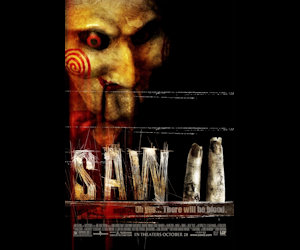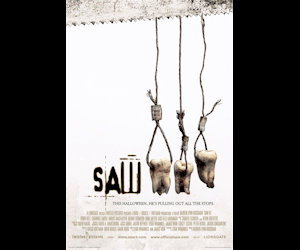The Saw Reviews
 | | Spoiler alert throughout |
With a brand-new entry in the hibernating Saw franchise, Jigsaw, releasing this weekend, now is as good a time as any to review all seven of the original Saw films. The series is maligned, at times unfairly, for being reprehensible, guilty pleasure entertainment that focuses on blood, guts, violence, and suffering with little in the way of artistic merit. While it certainly dips its toes in the muck from time to time, the Saw juggernaut isn't as mindless or morally bankrupt as its detractors believe. At their core, the movies deal with the moral ambiguity of law and order, as it is practiced legally or by a serial killer who doesn't feel responsible for the deaths he causes. Of course, Saw is primarily spectacle entertainment, and it definitely doesn't shy away from the horrific violence and cartoonish levels of gore, especially after the first two or three entries.
What I love most about the series, though, is the care with which it is written and produced. These films were all released a year apart from one another, and to be able to maintain even a modest amount of quality on such a tight schedule is laudable. These movies hold together a wildly complicated, intricate plot that relies on twist after turn after twist. The primary antagonist, Jigsaw, is a fascinating character study, and the Rube-Goldberg unraveling of events is always fun to watch. Therefore, I dispute the charge that these are cynical, heartless cash-grabs without merit. They might not be for everyone--indeed, they seem deliberately designed to infuriate critics and entertain horror fans--but for audiences who crave what Saw provides, these films hit the spot.
|
SAW (2004)
|  |
|
SAW (2004)
|  |
The Premise: Two men find themselves chained in an abandoned bathroom with a dead body and a cassette tape that explains the rules of a vicious game of life and death.
The Verdict: It's difficult to judge the original Saw without considering the franchise it created. However, if you can ignore its reputation of increasingly implausible torture porn and pointless violence, the first entry is surprisingly low-key, far less violent and gory than David Fincher's excellent Seven, from which it takes many cues. The writing and acting are largely well-done, and the concept is interesting. It's not a perfect film by any stretch--many of the ancillary sets are bland, suspension of disbelief is challenged by a twist-heavy third act, and the law enforcement characters are underdeveloped cop stereotypes--but for a film that relies mostly on two characters and an intricate plot, it's far more successful than it has any right being.
|
SAW II (2005)
|  |
|
SAW II (2005)
|  |
The Premise: As detective Eric Matthews closes in on the Jigsaw killer, a new group of victims awakens in a house filled with devilish puzzles to solve.
The Verdict: The first sequel sets the template by which all the other Saw sequels are made. This time, instead of one intricate trap, there is a whole series of them laid out for the victims to unravel, usually within an unreasonably short time limit. Instead of cutting away from the gore, the camera zooms in on it with wide focus, and while all this horror is playing out, a secondary plot involving the frankly incompetent police officers chasing Jigsaw is elaborated on. Then, in the end, there is a quick-cutting montage of flashbacks that reveal the plot twists, patch up lingering plot holes, and display a surprising attention to detail. For Saw II, the main storyline is carried by the inventiveness of the traps, while the secondary storyline is carried by the good performances from Donnie Walburg and Tobin Bell, who have excellent on-screen chemistry. What this sequel lacks in originality, it makes up for with improved production values all around, twists that are admittedly awesome, and a deep respect for narrative continuity that is all too rare.
|
SAW III (2006)
|  |
|
SAW III (2006)
|  |
The Premise: Jigsaw and his accomplice, Amanda, kidnap a doctor and force her to keep him alive as he orchestrates a new set of puzzles for a troubled man seeking vengeance for his dead son.
The Verdict: The third installment takes its time, and as a result, it doesn't really get interesting until half an hour in. The primary victim, Jeff, while well-written, is hard to get invested in, especially when he hesitates to save the lives of others. It's also frustrating how much the story switches its focus between Jeff and Lynn, the captive doctor. Having said all that, this has a stronger thematic core than its predecessor, and the twists in the final act, while predictable, continue to impress. The traps aren't as good, but the brain surgery scene stands out as arguably the most intense and disturbing sequence of the entire series. Saw III also deserves a ton of credit for having the balls to set up more sequels while simultaneously and unambiguously killing off the main villain.
-e. magill 10/26/2017
|
|